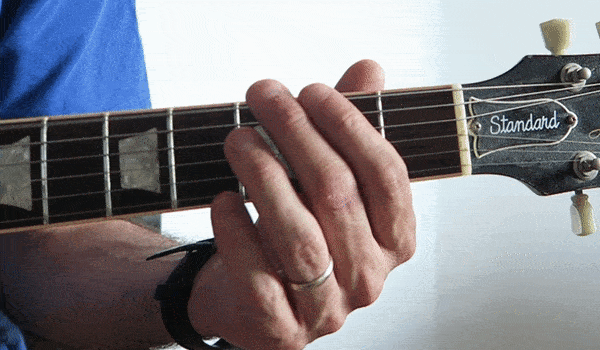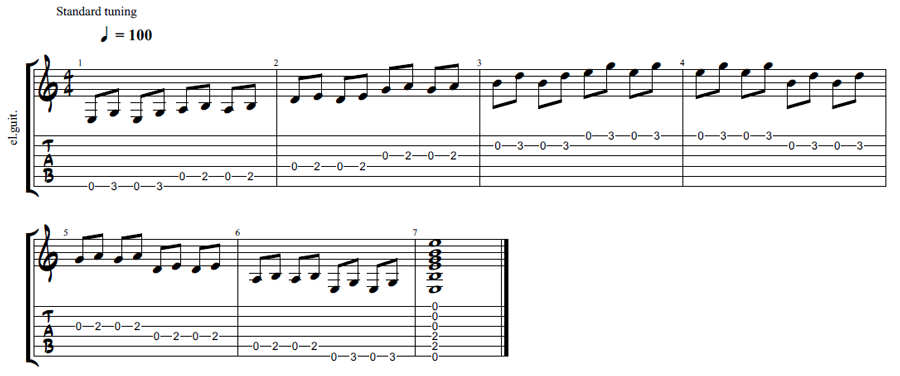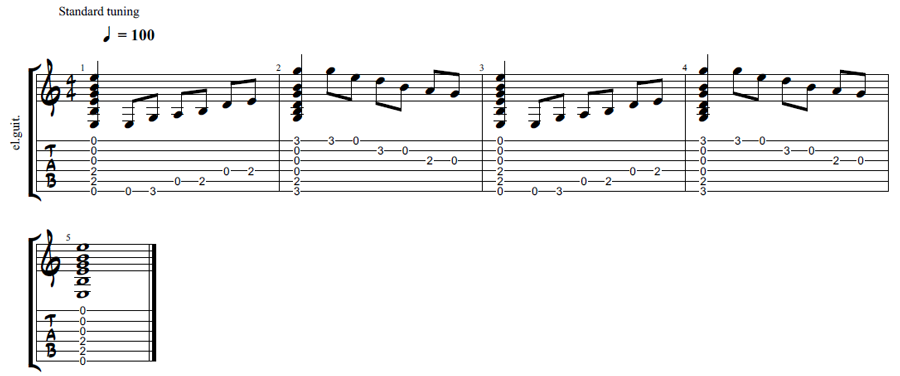Open Minor Pentatonic: The Easiest Guitar Scale
Learn A Beginner Scale Pattern That You Can Play With Just Two Fingers
In this tutorial, we're going to learn a super easy pattern useful to start playing scales.
Don't get me wrong, learning how to play scales up and down the fretboard requires a fair amount of practice and patience.
Please don't believe in claims like "Learn How To Play Lead Guitar in 7 Days", as there are no shortcuts, like often in life; anyway, this beginner tutorial will give you lots of fun and hopefully motivation for more complex studies.
So let's get started.
The Minor Pentatonic Scales
In this context I don't want to overload you with many music theory details, I just wish to give you a minimal amount of information to allow you to start having fun with scales. And what is the most popular and fun scale?
Of course, the Pentatonic Scale!
The Pentatonic scale is composed of 5 notes, and, as we'll see right below in this article, we can exploit open strings to come out with a very easy shape to play.
Using Open Strings To Make Things Easier
In the image below you can see how to play the E Minor Pentatonic Scale in open position:

As you can notice, this shape only requires the index and middle fingers... super easy!
Here below a fretboard diagram showing the E Minor Pentatonic Scale:

We use the words "open position" because this particular pattern is played with open strings; with then notes E, A, D, G and B you don't have to press any fret and this is what makes the pattern easy to play.
Remember that you can play almost any type of scale in open position, here you find some open major scales patterns.
Exercises With The Open Minor Pentatonic Strings
Double Notes On Strings
This first exercise helps you internalize the shape of the scale

Strings Crossing
This second exercise is more challenging, because it comprises many string crossings that require a good picking technique.

Mixing Chords And Single Notes
Here you play a mix of single notes and chords. It's a great way to understand how you can create riffs mixing scales and chords.

Adding One More Tone: The Blue Note
A great way to build on the pentatonic scale is to add the so-called Blue note. Play the pattern below and notice the bluesy feeling that the Bb note brings to the table.

You can still play this pattern using only the index and middle fingers, even if fingering the blue note will require a little bit of left-hand shifting.
The Pentatonic Scale Is Embedded In Human DNA
In his presentation at "2009 Notes; Neurons: In Search of the Common Chorus" conference, musician Bobby Mcferrin demonstrated how the sound of the pentatonic scale is sculpted in our brain, regardless of age, gender, or geographic location.
This video still surprises me, as it shows how music can join people in a unique and big vibration.
The Minor Pentatonic Scale - Some More Details
As previously said, the minor pentatonic scale is composed of 5 notes.
Its structure is the following:
In the key of E, this scale contains the notes:
You can get a good feel of the scale formula by playing it horizontally on the 6th string: start from the E lowest string and then play G (3rd fret), A (5th fret), B (7th fret), D (10th fret), E at the 12th fret, and back.

Minor Pentatonic Scale Note Names in all Keys
Yep, there is lot of information to process in the following table, but sometimes can be handy to know the note names for each key:
| 1 | b3 | 4 | 5 | b7 |
|---|---|---|---|---|
| C | Eb | F | G | Bb |
| G | Bb | C | D | F |
| D | F | G | A | C |
| A | C | D | E | G |
| E | G | A | B | D |
| B | D | E | F# | A |
| F# | A | B | C# | E |
| Gb | Bbb | Cb | Db | Fb |
| C# | E | F# | G# | B |
| Db | Fb | Gb | Ab | Cb |
| G# | B | C# | D# | F# |
| Ab | Cb | Db | Eb | Gb |
| D# | F# | G# | A# | C# |
| Eb | Gb | Ab | Bb | Db |
| A# | C# | D# | E# | G# |
| Bb | Db | Eb | F | Ab |
| F | Ab | Bb | C | Eb |
Experimenting With The Open Minor Pentatonic Scale
As open strings have a bigger and more powerful sound, this scale is perfect for building riffs: try to mix chords (G major and the E minor fit perfectly with this scale pattern, chords building theory explains you why) with single-note passages created on this scale.
Open Minor Pentatonic And Power Chords
You can also use power chords and palm muting if you want to create something hard'n heavy.
Power Chords are a kind of chord where the root note, played with the 5th interval, in a two-note chord , can be easily moved up and down the fretboard.
Power Chords are a modern invention linked to the use of distortion.
When using distortion, normal 3-note chords generate a lot of extra, conflicting harmonics that do not sound so good, which is why you seldom see rock guitarists playing straight chords.
Another scale with open strings with which you can have fun is the E major scale.
Open Minor Pentatonic And Palm muting
Palm-Muting the strings is a technique where you lightly (very lightly) place the edge of your strumming hand, or the edge of your palm over the strings right at the bridge.
This 'deadens' the sound slightly .
Open strings (and even some fretted notes) played with distortion have enough sustain to keep on going, until they actually create new harmonics at higher frequencies.
This is also called "feedback". It makes a high-pitched squealing sound . For a description, think, "a cat in a centrifuge".
This is fine if you are doing it on-purpose, but not if it happens just because you didn't learn how to Palm-Mute, so practice this technique a lot. It comes in handy in a lot of other playing situations besides just playing with distortion.
Some Examples of Songs Using Pentatonic scales
 Pentatonic Scales have a darker,
more
intense sound
Pentatonic Scales have a darker,
more
intense sound
. Most of the time, the Pentatonic Scale will be in a minor key, because minor intervals compliment the style perfectly.
Pentatonic Scales are used extensively in Blues , and a lot in Jazz, the folk music of Asia, Celtic, Scotland and Ireland, Eastern Europe, the Middle East, and even in Bluegrass, and Classical Music.
Chopin's Piano Etude in Gb was written entirely in the Pentatonic Scale.
Other popular songs done in pentatonic Scales are:
- The bass and lead runs in Low Rider (War)
- The lead and bass runs in My Girl (Four Tops)
- The lead riff in Wish You Were Here (Pink Floyd)
- The lead and bass in Sunshine Of Your Love (Cream/Eric Clapton)
- The lead in Iron Man (Black Sabbath)
- The lead in Honky Tonk Woman (The Rolling Stones/Keith Richards)
- The lead in Roadhouse Blues (The Doors)
- The lead in Heartbreaker (Led Zeppelin)
- Scarborough Fair (Traditional English Folk)
- Drunken Sailor (Irish Rovers), and many more
It would be a good idea for you to pull these up on YouTube, or Spotify, and listen to them before going on to the lesson. You will get an ear for what a Pentatonic Scale is supposed to sound like.
Open Minor Pentatonic Scale On Guitar: Conclusions
Learning pentatonic scales, and practicing them until you get silky smooth with them, can make you the hit of your next jam session or Open Mic. Remember, there is really no such thing as,"Too much practice". Have fun with your pentatonic!
To stay updated, subscribe here.